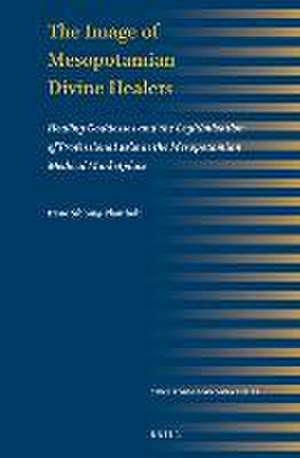The Image of Mesopotamian Divine Healers: Healing Goddesses and the Legitimization of Professional <i>asûs</i> in the Mesopotamian Medical Marketplace: Cuneiform Monographs, cartea 53
Autor Irene Sibbing-Plantholten Limba Engleză Hardback – 31 mar 2022
Din seria Cuneiform Monographs
- 18%
 Preț: 939.81 lei
Preț: 939.81 lei - 15%
 Preț: 540.47 lei
Preț: 540.47 lei - 18%
 Preț: 1652.48 lei
Preț: 1652.48 lei - 18%
 Preț: 1287.49 lei
Preț: 1287.49 lei - 18%
 Preț: 1075.02 lei
Preț: 1075.02 lei - 18%
 Preț: 929.10 lei
Preț: 929.10 lei - 18%
 Preț: 950.26 lei
Preț: 950.26 lei - 18%
 Preț: 802.67 lei
Preț: 802.67 lei - 18%
 Preț: 1156.00 lei
Preț: 1156.00 lei - 18%
 Preț: 948.27 lei
Preț: 948.27 lei - 18%
 Preț: 921.74 lei
Preț: 921.74 lei - 18%
 Preț: 1055.61 lei
Preț: 1055.61 lei - 18%
 Preț: 1151.35 lei
Preț: 1151.35 lei - 18%
 Preț: 1198.62 lei
Preț: 1198.62 lei - 18%
 Preț: 1142.66 lei
Preț: 1142.66 lei - 18%
 Preț: 1198.85 lei
Preț: 1198.85 lei - 18%
 Preț: 1046.06 lei
Preț: 1046.06 lei - 18%
 Preț: 1263.39 lei
Preț: 1263.39 lei - 18%
 Preț: 871.26 lei
Preț: 871.26 lei - 18%
 Preț: 721.44 lei
Preț: 721.44 lei - 18%
 Preț: 1053.65 lei
Preț: 1053.65 lei - 18%
 Preț: 579.24 lei
Preț: 579.24 lei - 18%
 Preț: 843.53 lei
Preț: 843.53 lei - 18%
 Preț: 1235.22 lei
Preț: 1235.22 lei - 18%
 Preț: 814.96 lei
Preț: 814.96 lei -
 Preț: 363.02 lei
Preț: 363.02 lei - 18%
 Preț: 1821.30 lei
Preț: 1821.30 lei - 18%
 Preț: 1006.80 lei
Preț: 1006.80 lei - 18%
 Preț: 883.08 lei
Preț: 883.08 lei - 18%
 Preț: 784.56 lei
Preț: 784.56 lei - 18%
 Preț: 1485.76 lei
Preț: 1485.76 lei - 18%
 Preț: 1175.74 lei
Preț: 1175.74 lei - 18%
 Preț: 631.61 lei
Preț: 631.61 lei - 18%
 Preț: 1074.06 lei
Preț: 1074.06 lei - 18%
 Preț: 862.92 lei
Preț: 862.92 lei - 18%
 Preț: 1205.72 lei
Preț: 1205.72 lei - 18%
 Preț: 1070.20 lei
Preț: 1070.20 lei - 18%
 Preț: 743.73 lei
Preț: 743.73 lei
Preț: 1010.22 lei
Preț vechi: 1231.98 lei
-18% Nou
Puncte Express: 1515
Preț estimativ în valută:
193.37€ • 210.11$ • 162.53£
193.37€ • 210.11$ • 162.53£
Carte disponibilă
Livrare economică 31 martie-14 aprilie
Preluare comenzi: 021 569.72.76
Specificații
ISBN-13: 9789004512405
ISBN-10: 9004512403
Dimensiuni: 155 x 235 mm
Greutate: 0.74 kg
Editura: Brill
Colecția Brill
Seria Cuneiform Monographs
ISBN-10: 9004512403
Dimensiuni: 155 x 235 mm
Greutate: 0.74 kg
Editura: Brill
Colecția Brill
Seria Cuneiform Monographs
Notă biografică
Irene Sibbing-Plantholt, Ph.D. in Assyriology (2017), University of Pennsylvania, is a postdoctoral research associate at the Freie Universität Berlin. She has published on the social history of health and healing, death and mortality, and emotions in ancient Mesopotamia.
Cuprins
Acknowledgements
Abbreviations
1 Newly Understanding Healing Goddesses and asûs: Theory and Methods
1.1Introduction
1.2Rethinking Healing Goddesses
1.3Rethinking Mesopotamian Healers
2 The Origins of the Healing Goddess Gula
2.1Gu₂-la₂ and Gula in the 3rd Millennium B.C.E.
2.2Disentangling Gula, Gu₂-la₂ and (U)kulla(b)
2.3Gula’s Involvement in Healing and Midwifery in the Ur III Period
3 Gula in the 2nd and 1st Millennia B.C.E.
3.1Gula in the Old Babylonian Period
3.2Gula in the 2nd Half of the 2nd Millennium B.C.E.
3.3Gula in the 1st Millennium B.C.E.
3.4Conclusion
4 Gula Compared to Other Healing Goddesses
4.1Ninkarrak
4.2Ninisina
4.3Bau
4.4Nintinuga
4.5Meme
4.6Comparative Analysis of the Healing Goddesses
5 An Overview of the Mesopotamian Medical Marketplace
5.1Lay and Domestic Healing
5.2Folk Healing
5.3Professional Healers: The Scholars
6 Rethinking the Term “asû”
6.1Asû as a General Term: “Healer”
6.2Different Types of asûs and Intersections with Other Healers
6.3The Functions and Work Environments of asûs
6.4Conclusion
7 Legitimization as a Response to Competition and the Demands of Clientele
7.1Medical Competition and the Need for Legitimization
7.2Promoting Erudition as a Scholarly Response to Medical Competition
7.3The Professional Asûs’ Solution to Competition: A Divine Image
8 The Process of Gula Becoming the Divine Legitimization of Professional asûs
8.1Healing Goddesses and Legitimization before the Middle Babylonian Period
8.2Gula Legitimizing Professional asûs from the Middle Babylonian Period
8.3Gula Representing Competition between Professional asûs and Other Healers
9 Conclusion and Suggestions for Future Research
Bibliography
Index
Abbreviations
1 Newly Understanding Healing Goddesses and asûs: Theory and Methods
1.1Introduction
1.2Rethinking Healing Goddesses
1.3Rethinking Mesopotamian Healers
Part 1 The Various Healing Goddesses and Their Relationship to asûs
2 The Origins of the Healing Goddess Gula
2.1Gu₂-la₂ and Gula in the 3rd Millennium B.C.E.
2.2Disentangling Gula, Gu₂-la₂ and (U)kulla(b)
2.3Gula’s Involvement in Healing and Midwifery in the Ur III Period
3 Gula in the 2nd and 1st Millennia B.C.E.
3.1Gula in the Old Babylonian Period
3.2Gula in the 2nd Half of the 2nd Millennium B.C.E.
3.3Gula in the 1st Millennium B.C.E.
3.4Conclusion
4 Gula Compared to Other Healing Goddesses
4.1Ninkarrak
4.2Ninisina
4.3Bau
4.4Nintinuga
4.5Meme
4.6Comparative Analysis of the Healing Goddesses
Part 2 Asûs in the Mesopotamian Medical Marketplace
5 An Overview of the Mesopotamian Medical Marketplace
5.1Lay and Domestic Healing
5.2Folk Healing
5.3Professional Healers: The Scholars
6 Rethinking the Term “asû”
6.1Asû as a General Term: “Healer”
6.2Different Types of asûs and Intersections with Other Healers
6.3The Functions and Work Environments of asûs
6.4Conclusion
Part 3 Legitimacy in the Medical Marketplace: Divine and Human Professional asûs
7 Legitimization as a Response to Competition and the Demands of Clientele
7.1Medical Competition and the Need for Legitimization
7.2Promoting Erudition as a Scholarly Response to Medical Competition
7.3The Professional Asûs’ Solution to Competition: A Divine Image
8 The Process of Gula Becoming the Divine Legitimization of Professional asûs
8.1Healing Goddesses and Legitimization before the Middle Babylonian Period
8.2Gula Legitimizing Professional asûs from the Middle Babylonian Period
8.3Gula Representing Competition between Professional asûs and Other Healers
9 Conclusion and Suggestions for Future Research
Bibliography
Index
